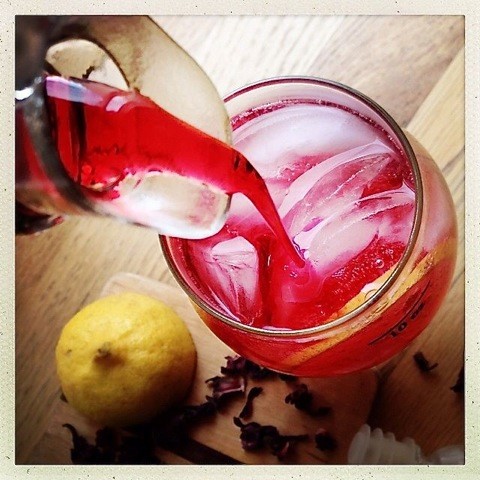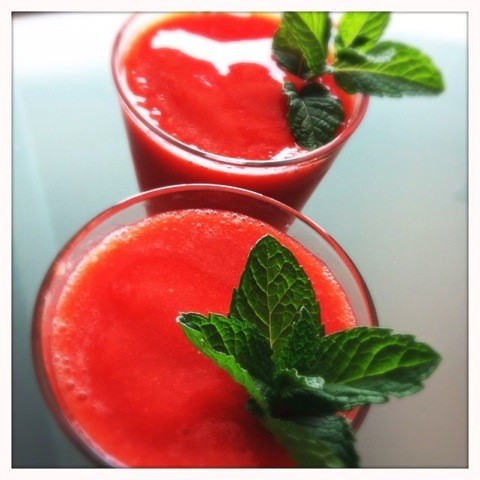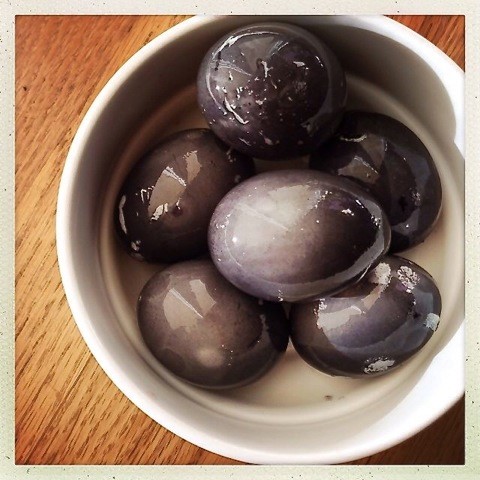Known across the globe by dozens of different names, the hibiscus flower captures our attention with its beauty and tantalizes our taste buds when brewed into a tangy, tea-like beverage. Countries around the world steep dried hibiscus flowers into an herbal infusion that can be served either hot or cold. The resulting beverage is known by different names depending on where in the world it’s brewed:
- Australia—rosella
- Caribbean—sorrel
- Egypt and Sudan—karkadé
- Ghana—soobolo
- India—gudhal or arhul ka phool
- Iran—Chai Torsh
- Iraq—Chai Kujarat
- Italy—carcadè
- Latin America—agua de Jamaica or rosa de Jamaica
- Philippenes—gumamela
- West Africa—bissap, tsoborodo, or wonjo
- West Indies and Thailand—roselle
How It Grows
There are several hundred species of hibiscus that grow all over the world. While hibiscus is native to temperate subtropical and tropical regions, certain varietals of the plant have been known to thrive as an indoor or outdoor plant across U.S. climates ranging from coastal to dessert to mountain.
The most marked characteristic of the hibiscus plant is its stunning flowers, which are large and trumpet shaped, and typically boast five or more petals. The flowers themselves range from 4 to 18 centimeters across depending on the plant. The hibiscus most commonly harvested, dried, and brewed into an herbal tea is the crimson red-colored flowers of the plant known as roselle, or Hibiscus sabdariffa. Yet different species of hibiscus produce a range of different colored flowers, including soft white, butter yellow, sunset orange, deep purple, bright blue, and pale pink. Some varietals even fade from one color to another.
Many species of hibiscus are used as landscaping trophies due to their stunningly beautiful flowers. The practical benefit is that the large flowers attract butterflies, bees, and hummingbirds, all of which are beneficial to a garden’s health and livelihood.
China and Thailand are the world’s top commercial producers and exporters of hibiscus. Mexico, Egypt, Senegal, Tanzania, Mali, Jamaica, India, and Malaysia also produce a lot of commercial hibiscus, but most of it is used or consumed locally. The world’s best hibiscus is said to come from Sudan, but the production output so low that few get to enjoy this high-quality export.
How It’s Used
Hibiscus is steeped and sipped all over the world. Infused in hot water, the crimson flowers brew into a ruby red liquor that can be described as tart like lemon and tangy like cranberry or pomegranate. Hibiscus can be slightly bitter as well, so the brewed beverage is often sweetened with sugar to cut down on any bitterness and tartness that comes through from steeping the flower. Hibiscus can also be blended with fruit or citrus juices, fresh ginger or mint, dried spices (like cinnamon and cloves), or even alcohol (like vodka, rum, or beer) to enhance, improve, or simply complement its unique flavor profile.
In addition to planting it for its beauty and harvesting it to brew as a beverage, there are other practical and symbolic uses for hibiscus in various cultures:
- Hibiscus is the state flower of Hawaii. It is said that a Hawaiian maiden wearing a hibiscus flower behind her right ear is looking for a mate; if she wears it behind her left ear, she is taken.
- Red hibiscus is the flower of the Hindu goddess Kali and often accompanies depictions of her in Indian art. The flower is also offered to the goddess in Hindu worship.
- Children in the Philippines play with hibiscus flowers by making bubbles. They crush the flowers into a juice and use hollowed papaya stalks as straws to blow bubbles with the sticky liquid.
- The stem of the hibiscus plant has strong fibres that some cultures turn into a material that can be used to make a natural fabric, like burlap.
- The green leaves of the hibiscus plant are used like an herb or spinach in some culinary applications. In Senegal, the leaves are used to flavor a traditional fish and rice dish, thieboudienne. In Burma, the leaves are the key ingredient to a classic curry dish, chin baung kyaw. In the Philippines, both the leaves and flowers are used as a sour, tangy ingredient to flavor the traditional tinola, or Polynesian chicken stew.
- Hibiscus flowers can be pickled, candied, and used dried or fresh to make a variety of condiments and dishes, including jams, jellies, syrups, salads, and desserts.
- Hibiscus flowers in whole or powdered form are often used as natural dying agents for cosmetics, fabric, and foods. A strong brew of hibiscus flowers can help color hair with warm, red highlights. The steeped flowers can be used to dye Easter eggs in colors ranging from light grey to dark purple depending on how much hibiscus is used and how long you steep the eggs in the tea. Hibiscus flowers can also be ground into a powder and used as a natural purplish-pink food coloring for frosting cakes and cupcakes.
How It’s Brewed
Hibiscus is most often brewed and sipped as a hot herbal tea. This herbal infusion is a caffeine-free alternative to black and green tea, which both contain the caffeine found naturally in true Camellia sinensis tea leaves. To balance the tartness and bitterness of the steeped flower, a hibiscus herbal infusion is often sweetened with sugar, honey, or agave. Serving hibiscus tea with a slice of lemon is a great way to bring out the flower’s citrus flavors.
To brew hot hibiscus tea: If your hibiscus came with specific recommendations for brewing, use those. But using about 1 to 2 teaspoons of loose hibiscus flowers or hibiscus herbal tea blend per 8 oz. cup of water is a safe bet. Place the loose flowers or tea blend in an infuser and set the infuser in a teacup. Pour just boiled water over the flowers and steep for 3 to 4 minutes. Remove the tea infuser and stir in sweetener and/or lemon if using. Sip and enjoy!
Hibiscus is also refreshing as an iced herbal tea. Our Teatulia® Hibiscus Berry Iced Tea blend is made from a combination of tart hibiscus flowers, tangy rose hips, naturally sweet stevia, and the fresh fruit flavors of strawberry, tangerine, and peach. This marriage of fresh, sweet, and tangy flavors brews into the ultimate iced tea beverage for hot summer days. And because it contains no true Camellia sinensis tea leaves, it’s a completely caffeine-free iced tea blend. We’re proud that our hibiscus iced tea blend was a 1st place winner in the 2013 North American Tea Championship.
To brew Teatulia Hibiscus Berry Iced Tea: Place one (1-ounce) portion pack iced tea bag in one gallon just boiled water. Steep for 3 to 4 minutes. Remove the tea bag and place the brewed tea in a sealed pitcher or other container in the fridge to chill. Enjoy over ice.
Whether you’re brewing a hot or a cold cup of hibiscus tea, here are a few general brewing tips to keep in mind:
- Use fresh, pure, cold filtered water. Spring water is best.
- Hibiscus is generally steeped in just boiled water at a temperature similar to a black tea and other herbal infusions, around 200 to 212 degrees.
- If you don’t have an electric kettle with temperature control, just remember that at sea level water simmers at 190 degrees and boils at 212 degrees. The boiling temperature drops about a degree for every 1,000 feet in altitude increase.
- Cover the container your hibiscus is steeping in to keep all the heat in the vessel.
- Hibiscus has a tartness that gets stronger the longer it steeps. Taste the brewed hibiscus after the recommended steeping time, then decide if you’d like it to go a little longer.
How It’s Stored
Hibiscus won’t ever really go “bad” but it can get stale. Just like any other tea or dried herb, hibiscus should be stored properly so it remains as fresh as possible on your shelf. Always buy hibiscus from a reputable company that can tell you when and how the tea was processed and packaged. Hibiscus will have the best flavor when brewed and enjoyed as soon as possible after its processing date. If stored properly, hibiscus can stay fresh and drinkable for up to two years. To ensure your hibiscus stays as fresh as possible as long as possible, take care to store it in a cool, dark place, away from light, oxygen, moisture and fragrant pantry companions like coffee or spices.
For more information about how to best care for your tea, visit our How to Store Tea page.
DIY Recipes
Hibiscus Simple Syrup

Ingredients:
1½ cups water
1½ cups sugar
4 tablespoons dried hibiscus flowers (or your favorite hibiscus tea blend)
Directions:
Whisk water and sugar together in a small saucepan. Bring to a boil, whisking constantly to dissolve sugar. Add hibiscus flowers and continue to boil for 5 minutes. Remove from heat, cover, and steep until almost cool. Strain syrup into a clean container and discard hibiscus flowers. Seal container and refrigerate until ready to use. Use 1 Tbsp. syrup per 8 oz. drink to flavor cocktails, sodas, or iced teas. It's also delicious spooned over ice cream or stirred into plain or vanilla yogurt.
Hibiscus Berry Frappé

(Adapted from the Hibiscus-Lavender Frappé recipe on the blog Tea Foodie. http://teafoodie.wordpress.com/2012/05/22/hibiscus-lavender-tea-frappe/)
Ingredients:
4 cups brewed Teatulia Hibiscus Berry Iced Tea*, chilled
2 cups frozen strawberries
2 teaspoons agave nectar (or more to taste)
Directions:
*To brew the Teatulia Hibiscus Berry Iced Tea: Place one (1-ounce) portion pack iced tea bag in one gallon just boiled water. Steep for 3 to 4 minutes. Remove tea bag and place brewed tea in a sealed pitcher or other container in the fridge to chill. This will yield one gallon of iced tea; you don’t need this much for the frappé, so you’ll have leftover iced tea to enjoy. To prepare the frappé: Add the frozen berries, agave nectar and 3 cups of the brewed Hibiscus Berry Iced tea to a blender. Blend thoroughly, adding the additional 1 cup (or more or less) of tea as necessary to facilitate smooth blending. Less tea results in a thicker frappé that you can eat with a spoon and more tea results in a thinner, smoothie-like drink.
Hibiscus Dyed Eggs

Ingredients:
1 dozen eggs
6 to 8 cups (or more) water
Directions:
Place eggs in a large saucepan. Cover eggs with at least an inch of cold water; this will be about 6 to 8 cups depending on your saucepan. Bring to a rolling boil over high heat for 5 minutes. Remove pan from heat, add hibiscus, cover, and let eggs sit for 15 minutes to finish cooking. (The more hibiscus flowers you use, the darker the final egg dye will be.) Using a slotted spoon, transfer the hard boiled eggs to a bowl of ice water to cool. Pour the hibiscus liquid (with the flowers) into a clean bowl. Once hibiscus liquid is cool (at least to room temperature), place cooled eggs back in the liquid, cover, and refrigerate overnight or up to 24 hours. Remove eggs from hibiscus liquid and discard liquid and flowers. Refrigerate eggs until ready to use.
Sources:
Hibiscus Tea via Wikipedia
Roselle via Wikipedia
Hibiscus via Wikipedia

